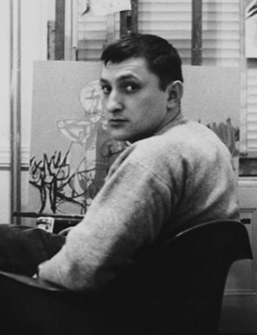
Described as creative, inspiring, kind-hearted, and a good soul who was generous with his time and words, Ernest R. “Ernie” Smith cared about the people who worked for him and believed in mentoring his staff. A true “renaissance man,” his talent spread far beyond creating exceptional advertising.
Ernest “Ernie” Smith was born in Los Angeles, California, He attended the Pittsburgh Art School and graduated from the California Art Institute. He began his career at S&H in 1951, and was hired as a designer by Herb Lubalin. During the 1950’s, companies found the need to compete more urgently for consumers’ attention, and designers suddenly needed to become innovative thinkers. Ernie’s career took off during this design revolution. Working closely with Herb Lubalin, his fascination with typography generated work that elevated type to the level of image. The art department won numerous awards and gained many new clients due to the revolutionary and expressive treatment of typography and design. Ernie’s mantra was to always bring something new to the subject.
With little physical space, a drawing board in Matt Hennessey’s office became his office. When Herb left the company, Ernie became an art director and in 1964, he was made creative director of S&H. Some of his key accounts included A.H. Robins, McNeil, and Parke-Davis, where he created memorable, award-winning designs for Benadryl and Zomax.
A powerful influence, Ernie did all the work on Ayerst Laboratories’ Inderal, one of the biggest, award-winning accounts in the agency. The account was so large that, under Ernie’s direction, an art director was assigned to each indication. During the golden age of consumer advertising, Ernie also designed the original PBS logo for channel 13, and the memorable Lucky Strike “Eve” package with Herb Lubalin, which is considered a design icon.
Robin Davenport, creative director at S&H, stated, “Ernie was a bit of a rebel, in that he was so strong and committed to what he wanted that he would often go head to head with account services from his passion to do the right thing and have the creative process be really strong. He nurtured junior talent – the era of the up and coming art directors — and gave them the freedom and license to inspire great creative. I got a lot of opportunities to work on big and major pieces of business because he believed in developing young talent.”
According to Diane Ohye, executive creative director at S&H, “Ernie was a great inventor of the compelling graphic image, what we at S&H call Indivisuality™, a graphic that really tells a story. The famous Benadryl ad (“Fathead”) was done in the era where he had to do a lot of retouching and had to conceive and execute at a very high level. We still look for that compelling and strong visual. Indivisuality™ continues to live on in examples like the Rocephin apple icon, etc. In this regard, Ernie’s work really influenced a way of thinking that created pioneering images that have endured for 20+ years.”
In 1967, Lubalin lured Ernie away from S&H to join him, and, with Tom Carnase, they formed a partnership and created Lubalin, Smith, Carnase, Inc.. In 1972, he moved to Bolton Landing to own and manage a resort, but spent his winter months working with Lubalin. In 1978, he returned to NYC and rejoined Lubalin, Smith, Carnase. Matt Hennessey asked him to re-join S&H in 1980, which he did, remaining there until his retirement in 1989.
Ernie created an atmosphere where people were allowed to do exceptionally fine work. He thought about how to create work, and tried to give people a sense of freedom and style while still creating his own. Working with the best photographers of his time, he frequently offered suggestions and was collaborative in his approach. He worked with other great artists such as Andy Warhol and Carl Fischer.
Known for his exceptional talent, gregarious personality, and storytelling ways, Ernie was a true renaissance man. Not only was he a designer and painter, but a historian, lecturer, author, jazz composer, and film collector as well. Those who worked with him described him as talented, generous, and most important, as a supportive teacher. Ernie was someone others could always go to. He was known for his talent with typography, but especially as the “Idea Man,” The S&H image is truly reflected in his collection of work and awards from Gold Medals to Art Directors Club awards.
Ernie Smith was a true craftsman during a time when there were no computers and design required a tremendous amount of work by hand. He was one of the first and foremost great designers of visual imagery and typography, the likes of which we may never see again.